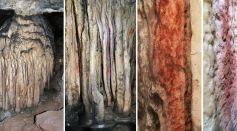Tags: Neanderthals

Denisovans: 200,000 Year Old Human Fossils Unearthed in SIberia
Ancient Human Species Identified: Study Introduces Homo Bodoensis, Who Lived in Africa 500,000 Years Ago
Neanderthals Are More Advanced Species; Studies Show Complex Tool-Making Techniques, Excellent Working Memory
'Lost Atlantis' Evidence Pieced Together with More Than 200 Objects Unveiled Through the Years

Do Neanderthals Recognize Art? European Cave Found with Stone Age Paintings, Possible Art Activity of Early Humans
Ancient Humans Had Bigger Bodies to Combat the Cold; Will Changing Climate Shrink Present Humans?
Unicorn Bones Found? Nope, Neanderthals Just Carved Artwork on Toe Bone of Extinct Giant Deer
51,000-Year-Old Bone Carving Discovered in Northern Germany: Evidence of Neanderthals' ‘Sophisticated Behavior’
'Dragon Man': Could Be the Closest Human Species to Homo Sapiens than Neanderthals?
Neanderthal-Like Bones Unearthed in Israel Complicates Human Lineage
Neanderthal Diet Study Shows They Ate Starchy Foods 600,0000 Years Ago to Fuel Their Brains
Modern and Archaic Humans: New Method Reveals Genetic Differences
Neanderthals Extinction Caused by Lack of Important Skill That Homo Sapiens Have
Neanderthals Adjusted Well to Cold Climates, Researchers Tell Us How
Neanderthal Contributions to the Modern Man, Six Other Human Species Explained
DNA Shows Early European Migrants Regularly Interbred with Neanderthals
Beyond Artistic Bias: Scientists Release "More Accurate" Representations of Ancient Hominids
Origins of Hobbit Species Could Be Traced Back To Denisovans and Neanderthals
Neanderthals Could Hear? May Have Understood, Recognized Human Speech Like Modern-Day Man
Cave Discoveries Suggest Closer Link Between Neanderthals & Homo Sapiens Stone Technology
Most Popular

Can EV Batteries Be Recycled? How Lithium Recovery Supports Sustainable Batteries

Coral Bleaching Crisis: How Ocean Warming Threatens Marine Ecosystems Worldwide

NASA Aurora Research Reveals How ESA Space Weather Teams Use Satellite Aurora Imaging and Ground Sensors

V2G Technology: How EV Energy Storage Utilizes Smart Grid and Renewable Energy Integration





